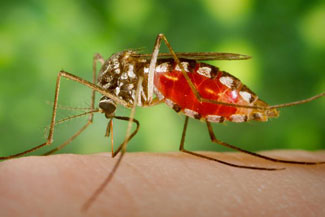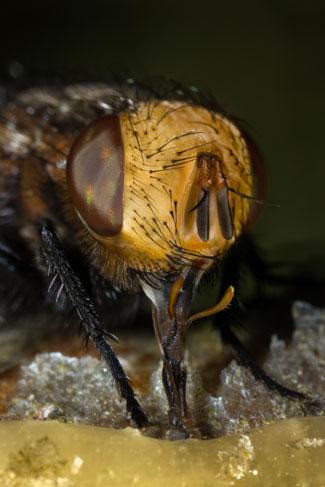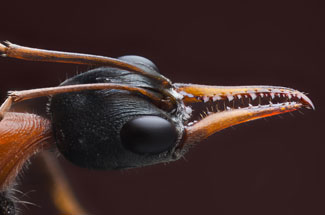How Insects Eat – Pierce, Slurp, Suck, Chew
By Chris Williams on June 24, 2014.

Proboscis of a mosquito

Proboscis of a Tachina Fly

Mandibles of a bull ant
One reason that insects are so successful is that they are specialized. They even have mouthparts that are customized for their lifestyle and the type of food they eat. Some chew, some slurp, some pierce and suck.
Piercing-Sucking Mouthparts
Some insects have a mouth that is essentially a hypodermic needle. Mosquitoes, bed bugs, fleas, stable flies, plant bugs (including stink bugs) and head lice all poke a hole and then suck up fluid through the same opening. Their needle-like mouthparts consist of several parts that come together to form a feeding tube called a “proboscis.” Many insects with piercing-sucking mouthparts feed on blood, can bite people, and can spread disease, but some like aphids and stink bugs, suck only plant juices.
Sponging Mouthparts
Other insects have a proboscis that has an enlarged spongy tip that allows them to eat liquid or semi-liquid foods. House flies, blow flies, flesh flies, and fruit flies have sponging mouthparts that can’t bite people. Some of these flies regurgitate saliva onto solid food to dissolve it so they can then lap it up with their spongy mouthparts.
Chewing Mouthparts
Cockroaches, crickets, grasshoppers, ants, praying mantids, and beetles have chewing mouthparts similar to our teeth, except they’re called “mandibles” and they move sideways. Insects with these mouthparts bite off and grind solid food, much like we do. A few have powerful mandibles and can bite people. Besides the large pair of tearing mandibles, small mouth “feelers” help to manipulate, taste, and smell the food before it is swallowed.
Many insects have mouthparts that are a combination of the three types above. For instance, bees have chewing mandibles, but they also suck liquid through a beak-like tongue. A butterfly has a long sucking proboscis that it keeps coiled up under its head. Instead of using its proboscis to pierce, it uses it to siphon up nectar.
A very few insects, like mayflies, have no functional mouthparts at all. They live only a few days with the sole purpose of mating and laying eggs, and don’t need to feed.
Fly photo: By Richard Bartz (Own work) [CC-BY-SA-2.5], via Wikimedia Commons
Mosquito photo: By James Gathany [Public domain], via Wikimedia Commons
Ant photo: By Matt Inman (Own work) [CC-BY-SA-3.0], via Wikimedia Commons